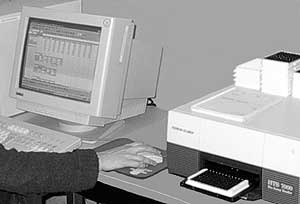
Edition 10 - December, 2001
 Edition 10 - December, 2001 |
Microplate DNA-DNA hybridization for reliable identification of acetic acid bacteria |
Acetic acid bacteria comprise a widespread group of gram-negative, obligate aerobic, rods. They occur mainly in sugary, acidic and/or alcoholic habitats and have been studied extensively since they can play a positive, neutral or detrimental role in foodstuffs and beverages.
Acetic acid bacteria are classified into the genera Acetobacter, Gluconacetobacter, Gluconobacter, Acidomonas and the recently described genus Asaia. These genera join phylogenetically into a broad rRNA cluster within the a-subclass of the Proteobacteria, the acetic acid bacteria lineage.
Although there have been several studies on the taxonomy of the acetic acid bacteria, some problems remain such as: the differentiation of the species by phenotypic characters is problematic and sometimes impossible; the range of the DNA base composition of several species is broad, which indicates that they may harbor more than one biological entity; and there are species lacking data of DNA-relatedness between the strains comprising them.

|
At BCCM/LMG, a study was initiated to improve the identification of Gluconacetobacter and Acetobacter strains and to further elucidate the taxonomy of these genera. To achieve these goals, 20 Gluconacetobacter strains currently assigned to G. diazotrophicus, G. liquefaciens, G. xylinus, G. europaeus, G. intermedius, G. oboediens and G. hansenii were investigated by DNA-DNA hybridization, and 16 strains from the heterogeneous species A. pasteurianus as well as 17 strains representing A. aceti, A. pomorum, A. peroxydans, A. lovaniensis, A. estunensis, A. orleanensis, A. indonesiensis and A. tropicalis were subjected to a polyphasic study that included DNA-DNA hybridizations, DNA base-ratio determinations, 16S rDNA sequence analysis, and phenotypic characterization.
The results revealed the existence of two new Acetobacter species, A. cerevisiae and A. malorum (Cleenwerck et al., submitted to IJSEM) and confirmed the need for genotypic characterization across these genera for identification on the species level. This study also confirmed that DNA-DNA hybridization is presently the technique of choice for the accurate identification of Gluconacetobacter and Acetobacter strains. Therefore, as a routine service to the scientific community, BCCM/LMG offers its DNA-reference frame for the identification of acetic acid bacteria.
author: Ilse Cleenwerck
Contact
Dr. Danielle Janssens
Tel.: +32 (0)9 264 51 08
Fax: +32 (0)9 264 53 46
E-mail: bccm.lmg@rug.ac.be
Home |
Contents Edition 10 - December, 2001 |